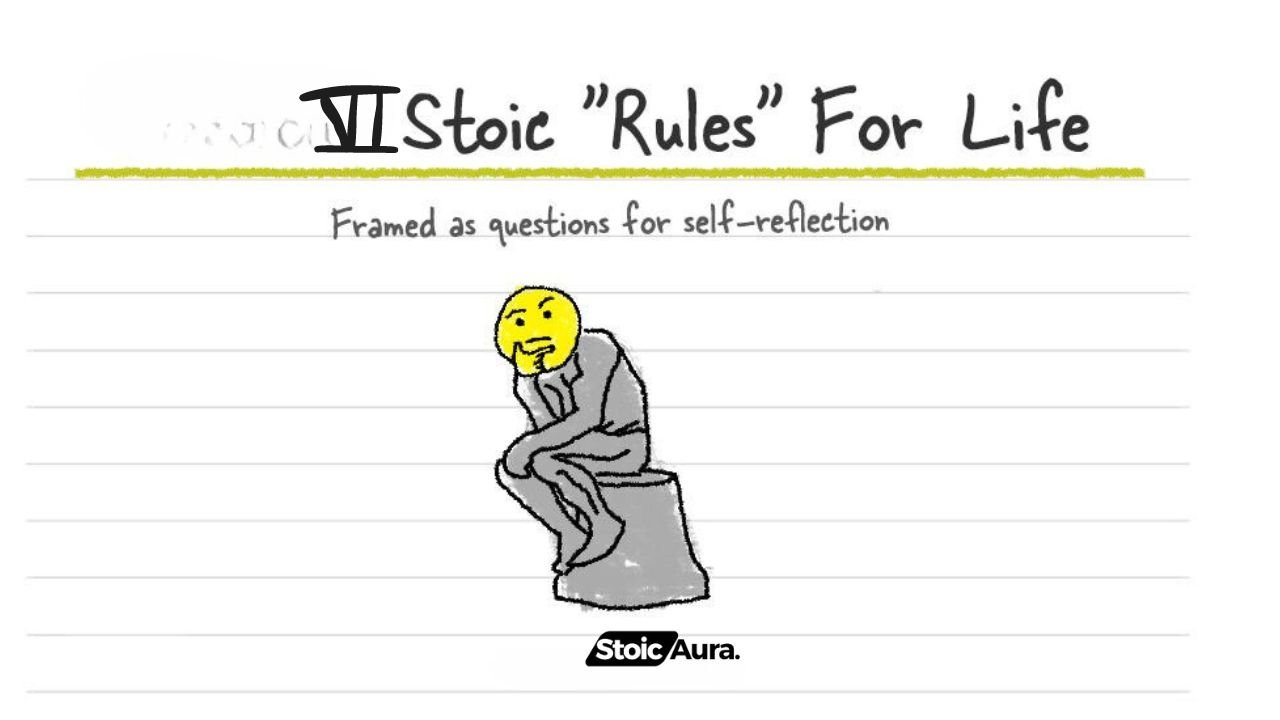I. Introduction
A . Brief explanation of Stoicism’s relevance
Welcome to the world of Stoicism, a timeless philosophy with enduring relevance. Stoicism, often associated with being stoic, transcends a mere philosophical concept; it’s a guide to navigating life’s complexities with resilience and wisdom. Rooted in ancient wisdom, Stoicism teaches us to face challenges with a calm, rational demeanor. Embracing the Stoic mindset involves acknowledging that external circumstances are beyond our control, urging us to focus on internal virtues. By understanding and applying Stoicism’s principles, individuals can lead more purposeful, balanced lives, making it a beacon of timeless wisdom in our ever-evolving world.
II. Unveiling the First Rule: Accept What You Can’t Control

A. Embracing Stoic Principles
1. Defining Stoicism and its core tenets
Delve into the profound world of Stoicism, a philosophy that serves as a guiding light for navigating the complexities of life. At its core, Stoicism is not just a set of beliefs but a practical approach to living with resilience and tranquility. Rooted in ancient Greek philosophy, particularly championed by thinkers like Zeno of Citium, Stoicism teaches individuals to embrace challenges with a calm and rational mindset. The Stoic philosophy revolves around the idea that while external events are beyond our control, we possess the power to control our responses and attitudes. By cultivating virtues such as wisdom, courage, justice, and temperance, Stoicism fosters emotional resilience and a sense of purpose.
Imagine facing adversity with the equanimity of a Stoic sage, finding strength in adversity and maintaining inner peace amidst the chaos. Stoicism’s teachings resonate through the ages, providing practical wisdom for navigating the ever-changing tides of life. In embracing Stoicism, individuals discover a timeless guide that transcends cultural and temporal boundaries, offering solace and wisdom in our modern journey.
2. Exploring the importance of acceptance in daily life
Embarking on the Stoic journey unveils the profound significance of acceptance in our daily lives. At the heart of Stoicism lies the recognition that certain aspects of life are beyond our control, urging us to embrace acceptance as a powerful tool for cultivating tranquility. By adopting a Stoic perspective, individuals learn to navigate the unpredictability of existence with grace, understanding that external events are transient and often uncontrollable. This philosophy encourages a shift in focus from attempting to manipulate external circumstances to developing an internal fortitude, rooted in the virtues of wisdom, courage, and resilience.
Imagine the liberation that comes from embracing life’s uncertainties without succumbing to anxiety. Stoicism teaches that acceptance is not a passive surrender but an empowering acknowledgment of our capacity to shape our responses. Through anecdotes of Stoic sages and practical wisdom, this philosophy illustrates the transformative impact of acceptance on our mental well-being. In a world constantly in flux, Stoicism offers a timeless roadmap to serenity by emphasizing the profound importance of accepting the things we cannot change and finding strength in navigating life’s unpredictable currents.
B. Real-life Applications
1. Examples illustrating the concept of accepting the uncontrollable
In the tapestry of Stoicism, the threads of acceptance weave a narrative of resilience and empowerment, providing vivid examples of individuals navigating the unpredictable with grace. Consider the ancient Stoic philosopher Epictetus, who, despite facing enslavement, found freedom by accepting his circumstances and focusing on his inner virtues. The story of Marcus Aurelius, a Stoic emperor, reflects the philosophy’s emphasis on accepting the uncontrollable aspects of ruling an empire, guiding him to rule with wisdom and equanimity. Modern examples abound, such as Viktor Frankl, a psychiatrist and Holocaust survivor, who embraced Stoic principles to endure the unimaginable, finding meaning in the face of suffering.
These narratives illustrate the practical applications of Stoic acceptance, showing that by acknowledging the limits of our control, we gain the strength to weather life’s storms. Stoicism becomes a beacon of wisdom in turbulent times, urging individuals to accept the uncontrollable, finding serenity in the midst of chaos. Through these examples, Stoicism emerges not as an abstract philosophy but a lived experience, where the art of acceptance becomes a transformative force, allowing individuals to flourish even in the face of life’s uncertainties.
2. Practical tips for integrating acceptance into one’s mindset
Embracing the tenets of Stoicism isn’t merely a philosophical exercise but a practical guide to navigate the twists and turns of life. To integrate the core principle of acceptance into one’s mindset, consider the wisdom of the Stoic sage Seneca, who advised cultivating a daily practice of reflecting on the unpredictability of life. This involves acknowledging that not everything is within our control and focusing our energies on what is. Seneca’s notion of “premeditatio malorum” or premeditation of evils encourages contemplating potential challenges, preparing the mind to respond with equanimity when adversity arises.
Another practical tip is to adopt a gratitude practice, a Stoic-inspired ritual to appreciate the present moment and the aspects of life within our control. Reflecting on what we have rather than what we lack fosters contentment and reinforces the Stoic concept of accepting the inherent nature of life. By weaving these Stoic principles into daily life, individuals can gradually shift their mindset towards acceptance, transforming challenges into opportunities for growth, and finding tranquility amidst the ebb and flow of existence. Stoicism, thus, becomes a companion on the journey of life, offering practical tools for navigating the unpredictable with grace and wisdom.
III.The Second Rule: Control Your Responses

1. Understanding the Stoic perspective on emotions
In the vast landscape of Stoicism, the approach to emotions stands as a cornerstone, reflecting a profound understanding of human psychology. Stoics, such as the revered philosopher Epictetus, advocated for a balanced and mindful relationship with emotions. According to Stoicism, emotions are not inherently good or bad but rather responses shaped by our interpretations of events. The Stoic perspective encourages individuals to cultivate emotional resilience by questioning and reframing their perceptions, fostering a mindset where one can respond to life’s challenges with equanimity.
For instance, when faced with adversity, a Stoic would examine their emotional response, seeking to understand the underlying beliefs that triggered such feelings. This introspective practice allows individuals to detach from automatic reactions and, instead, choose deliberate, reasoned responses. This approach doesn’t negate the importance of emotions but transforms them into tools for self-awareness and personal growth.
By embracing the Stoic view on emotions, individuals can navigate the complexities of life with a sense of control and inner peace. Stoicism becomes a guide, offering practical insights on how to acknowledge and channel emotions constructively, ultimately leading to a more balanced and fulfilling life.
2. Strategies for maintaining emotional balance in challenging situations
Navigating life’s challenges with emotional balance is a skill honed by the timeless wisdom of Stoicism. In the Stoic philosophy, maintaining equanimity in the face of adversity involves adopting practical strategies that empower individuals to respond thoughtfully rather than react impulsively. A cornerstone of these strategies lies in acknowledging the dichotomy of control—focusing energy on what is within one’s sphere of influence while accepting what lies beyond it. By cultivating this mindset, Stoicism encourages individuals to approach challenging situations with a sense of agency and composure.
Moreover, Stoics emphasize the power of perspective, urging individuals to view setbacks as opportunities for growth. This shift in perception reframes adversity as a natural part of life, inviting a resilient response rather than succumbing to emotional turmoil. Drawing inspiration from Stoic principles, individuals can develop a mental toolkit that includes mindfulness practices, rational analysis of situations, and intentional reflection.
In the tapestry of Stoicism, these strategies are woven together to create a fabric of emotional resilience, enabling individuals to face challenges with grace and fortitude. Stoicism, with its friendly guidance, becomes not just a philosophy but a companion on the journey toward a balanced and fulfilling life.
B. Stories of Stoic Resilience
1. Anecdotes showcasing individuals exemplifying controlled responses
Throughout history, numerous individuals have exemplified the Stoic virtue of controlled responses in the face of adversity. One such example is Marcus Aurelius, the renowned Stoic philosopher and Roman Emperor. Despite facing immense challenges and pressures as a ruler, Marcus Aurelius remained steadfast in his commitment to Stoic principles, maintaining composure and rationality in all situations. His Meditations, a collection of personal writings, reflects his unwavering resilience and disciplined approach to life’s trials. Similarly, Nelson Mandela, the iconic South African leader, demonstrated remarkable stoicism during his long imprisonment and subsequent struggle against apartheid. Despite enduring decades of confinement and injustice, Mandela maintained a dignified demeanor and a steadfast commitment to non-violence, embodying the Stoic ideal of inner peace amidst external turmoil. These anecdotes serve as poignant reminders of the power of Stoicism to cultivate resilience, wisdom, and equanimity in the face of life’s challenges, inspiring individuals to embrace a more stoic mindset in their own lives.
2. How the second rule contributes to personal growth
In the realm of Stoicism, the second rule serves as a beacon guiding individuals toward profound personal growth. This tenet, emphasizing the importance of distinguishing between what is within one’s control and what is not, becomes a transformative tool for self-discovery. By understanding and internalizing this rule, individuals embark on a journey of self-mastery and resilience. The Stoic philosophy encourages us to invest our energy in shaping our responses to life’s challenges rather than futilely trying to manipulate external circumstances beyond our control.
Through this lens, personal growth blossoms. Stoicism teaches that true power lies in our reactions to events, prompting a shift from a reactive mindset to a proactive one. This wisdom encourages intentional living, fostering a sense of agency and empowerment. As individuals learn to navigate the ebb and flow of life with Stoic principles as their guide, they not only weather adversities with grace but also cultivate an enduring foundation for personal development. In the friendly embrace of Stoicism’s second rule, individuals find a pathway to growth, resilience, and an enriched life journey.
IV. Rule Number Three: Differentiating Between
Internal and External

A. Dive into Stoic Dichotomy of Control
1. Expanding on the concept of distinguishing between internal and external factors
Within the realm of Stoicism, the profound concept of distinguishing between internal and external factors emerges as a cornerstone of emotional resilience. This tenet encourages individuals to hone their focus on elements within their control while releasing undue concerns about external circumstances. By embracing this Stoic principle, practitioners develop a robust mental framework that shields them from the capricious nature of the outside world. Imagine a sailboat navigating turbulent waters; Stoicism provides the rudder, allowing individuals to steer their emotional course despite the unpredictable waves.
In this friendly philosophical terrain, the distinction between what one can influence and what remains beyond control becomes a guiding light. For example, a Stoic may encounter a challenging work situation and, rather than fixating on external pressures, concentrate on maintaining personal integrity and work ethic. This intentional focus on the internal empowers individuals to cultivate emotional well-being irrespective of external turbulence. The Stoic philosophy, in its friendly wisdom, thus offers a transformative perspective, urging practitioners to navigate life’s complexities by fostering resilience through the discernment of internal and external realms.
2. Practical exercises for identifying and focusing on the internal
Embarking on the Stoic journey involves not just understanding but actively practicing the art of discerning between the internal and external factors that shape our lives. One practical exercise rooted in Stoicism is the daily reflection, a friendly and transformative habit. Each day, take a moment to reflect on events and emotions, categorizing them into two spheres: the internal, within your control, and the external, beyond your influence. This mindful categorization serves as a friendly reminder of the Stoic principle, enabling you to focus your energy on aspects you can shape.
Consider a scenario where a Stoic practitioner faces a traffic jam. Rather than succumbing to frustration about external factors, they use this exercise to identify their internal reactions—perhaps impatience or annoyance. By acknowledging these emotions, they gain clarity on what lies within their control: the choice of response. This intentional reflection becomes a friendly guide, fostering emotional resilience by redirecting attention to the internal locus of control.
As this practice becomes ingrained, the Stoic philosophy not only becomes a theoretical framework but a practical tool for navigating life’s complexities with grace and composure. The simplicity and effectiveness of such exercises enhance the friendly and accessible nature of Stoicism, turning its principles into lived experiences.
B. Crafting a Stoic Lifestyle
1. Applying the third rule to various aspects of life
In the tapestry of Stoic philosophy, the third rule unfolds as a friendly guide to steering life’s journey with equanimity and purpose. It beckons practitioners to cultivate a mindset of adaptation and resilience, recognizing the transient nature of external circumstances. This principle, deeply rooted in Stoicism, encourages individuals to embrace change with open arms. Picture a Stoic facing the unpredictable tides of a career shift. Rather than resisting the ebb and flow, they employ the Stoic lens, acknowledging the impermanence of external roles and titles.
The application of this rule extends to personal relationships, where a Stoic’s friendly demeanor is a testament to their adaptability. When navigating the ever-shifting dynamics of friendships or family, they focus on internal virtues—kindness, empathy, and understanding—rather than fixating on external expectations. This pragmatic approach fosters a sense of freedom, as Stoics learn to find stability within themselves amid life’s constant fluctuations. Through this application, the third rule of Stoicism becomes a practical compass, guiding individuals toward a resilient and adaptable way of living, navigating the nuances of existence with grace and composure.
2. Encouraging readers to live a more Stoic existence
Embarking on a more Stoic existence is an invitation to transform the way we engage with life’s tapestry, weaving threads of resilience, wisdom, and tranquility. Picture a journey where challenges become opportunities, and setbacks are reframed as stepping stones. By embracing Stoicism, individuals are equipped with a friendly toolkit for navigating the complexities of the human experience. It’s not about suppressing emotions but understanding their transient nature and choosing a thoughtful response. Practicing Stoicism invites you to dance with the rhythm of life, finding joy in the present moment and cultivating a mindset resilient to the unpredictable tides of fate.
Think of Stoicism as a friendly mentor guiding you through the labyrinth of existence, offering timeless principles to enhance your mental well-being. It empowers you to discern between what’s within your control and what isn’t, fostering a sense of inner calm amid life’s whirlwinds. Living a more Stoic existence doesn’t mean detachment but an enriched engagement with the world, where external circumstances hold less sway over your internal serenity. It’s an open invitation to befriend wisdom, resilience, and contentment as steadfast companions on your life’s journey.
V. The Final Rule: Live in Accordance with Nature

A. Nature as the Stoic Guide
1. Interpreting the Stoic understanding of nature
In the realm of Stoicism, nature isn’t merely the flora and fauna that surround us but a profound understanding of the cosmic order and our place within it. Picture nature as a wise friend, imparting timeless lessons on harmony, interconnectedness, and purpose. Embracing the Stoic perspective on nature invites individuals to align their lives with the inherent order of the universe, cultivating a sense of tranquility in the process. It’s like learning to dance with the rhythm of the cosmos, recognizing that the challenges and triumphs we face are part of a grander, interconnected narrative.
Stoicism, in its friendly wisdom, encourages us to study and learn from the patterns of the natural world, finding solace and inspiration in its constancy. The seasons change, and so do the circumstances of our lives. By observing nature, we glean insights into the cyclical nature of challenges, growth, and renewal. This Stoic interpretation of nature becomes a gentle guide, encouraging us to navigate life’s currents with a deeper understanding, fostering resilience, and nurturing a profound connection to the world around us. In the friendly embrace of Stoicism, nature becomes not just an external force but a source of timeless wisdom, offering a blueprint for a more harmonious and fulfilling existence.
2. How aligning with nature enhances the Stoic way of life
In the heart of Stoicism lies the profound principle of aligning with nature as a guiding force for a more meaningful existence. This harmonious dance with the natural order isn’t a distant philosophy but a practical approach to living a Stoic life. Picture it as a friendly collaboration with the universe, where we synchronize our intentions, actions, and reactions with the rhythm of the cosmos. By aligning with nature, Stoicism teaches us to embrace the ebb and flow of life, accepting both joys and challenges with equanimity.
Stoics see in nature a blueprint for virtue, resilience, and authenticity. The changing seasons symbolize the impermanence of life, urging us to adapt gracefully. Just as nature exhibits balance and interconnectedness, the Stoic way involves harmonizing our desires with the greater good. Aligning with nature doesn’t mean escaping the complexities of existence but navigating them with a friendly understanding. It’s an invitation to embrace the present, learn from the past, and face the future with serene acceptance. In weaving our lives into the fabric of nature, Stoicism provides a friendly roadmap to cultivating wisdom, virtue, and an enduring sense of peace.
B. Concluding Thoughts
1. Summarizing the four rules of Stoicism
Embarking on the Stoic journey involves embracing four foundational rules that guide individuals towards a more serene and fulfilling life. At the core of Stoicism is the understanding that one’s control extends only to their own thoughts and actions. By acknowledging this truth, Stoics free themselves from the shackles of external events, fostering resilience and inner peace. The second rule encourages the distinction between what’s within our control and what isn’t, prompting a shift in focus towards the internal realm where true agency resides. This empowers individuals to navigate life’s twists with grace and fortitude.
The third rule invites practitioners to align their lives with nature, recognizing the interconnectedness of all things and finding wisdom in this harmony. It’s an invitation to live authentically, in sync with the natural order of the universe. Finally, the fourth rule emphasizes the practice of constant improvement, urging Stoics to cultivate virtue and wisdom throughout their lives. Together, these rules create a friendly roadmap for a Stoic existence, offering practical insights into accepting the uncontrollable, focusing on the internal, aligning with nature, and perpetually striving for personal betterment. In adopting these principles, one can embark on a journey towards a more purposeful, resilient, and content life in the spirit of Stoicism.
2. Encouraging readers to embark on their Stoic journey with newfound insights.
Embarking on a Stoic journey is akin to setting sail on a transformative odyssey toward a more balanced and resilient life. As we delve into the profound teachings of Stoicism, embracing its core tenets, a wealth of insights awaits. Stoicism provides a compass for navigating the unpredictable seas of life, empowering individuals to weather storms with a calm and composed spirit. By integrating Stoic principles into daily living, readers can cultivate a mindset that transcends challenges, fostering inner strength and emotional well-being. The Stoic journey encourages self-reflection, acceptance of the uncontrollable, and the pursuit of virtue and wisdom.
As fellow travelers on this philosophical expedition, we discover that Stoicism is not a rigid set of rules but a friendly guide offering timeless wisdom. Through stories of ancient Stoics and modern practitioners, the journey becomes relatable, illustrating the enduring relevance of these teachings. By embarking on this voyage, readers unlock the potential for personal growth, enhanced relationships, and a profound sense of purpose. So, with open hearts and eager minds, let us navigate the seas of Stoicism together, charting a course toward a more fulfilling and meaningful existence.
Certainly! Let’s address some Frequently Asked Questions (FAQs) related to Stoicism and then conclude with a summary.
FAQs about Stoicism:
1. What is Stoicism?
Stoicism is a philosophical school of thought founded in ancient Greece, emphasizing virtue, wisdom, and rationality. It teaches the development of self-control and resilience in facing life’s challenges.
2. Who were notable Stoic philosophers?
Prominent Stoic philosophers include Zeno of Citium, Seneca, Epictetus, and Marcus Aurelius, each contributing to the development of Stoic principles.
3. How can Stoicism be applied to daily life?
Stoicism provides practical tools for managing emotions, dealing with adversity, and pursuing a virtuous life. Techniques like negative visualization and the dichotomy of control are often employed.
4. Is Stoicism still relevant today?
Yes, Stoicism remains highly relevant. Its teachings on resilience, acceptance, and focus on what is within our control resonate with individuals seeking a balanced and meaningful life.
Conclusion:
In conclusion, Stoicism offers timeless wisdom applicable to modern challenges. By embracing the Stoic principles of acceptance, focusing on the internal, aligning with nature, and pursuing virtue, individuals can cultivate a resilient mindset. The journey of living in accordance with Stoic philosophy is an ongoing process, empowering individuals to navigate life’s complexities with grace and wisdom. As we reflect on these principles, may we find inspiration to embark on our Stoic journey, embracing the profound insights that Stoicism offers for a more fulfilling life.







